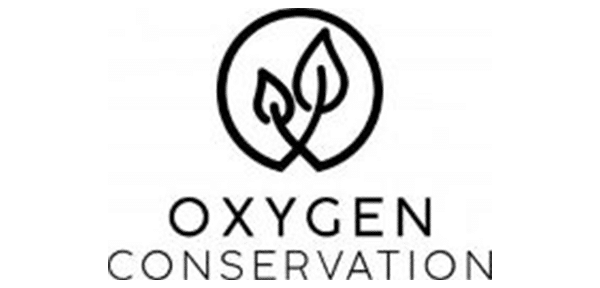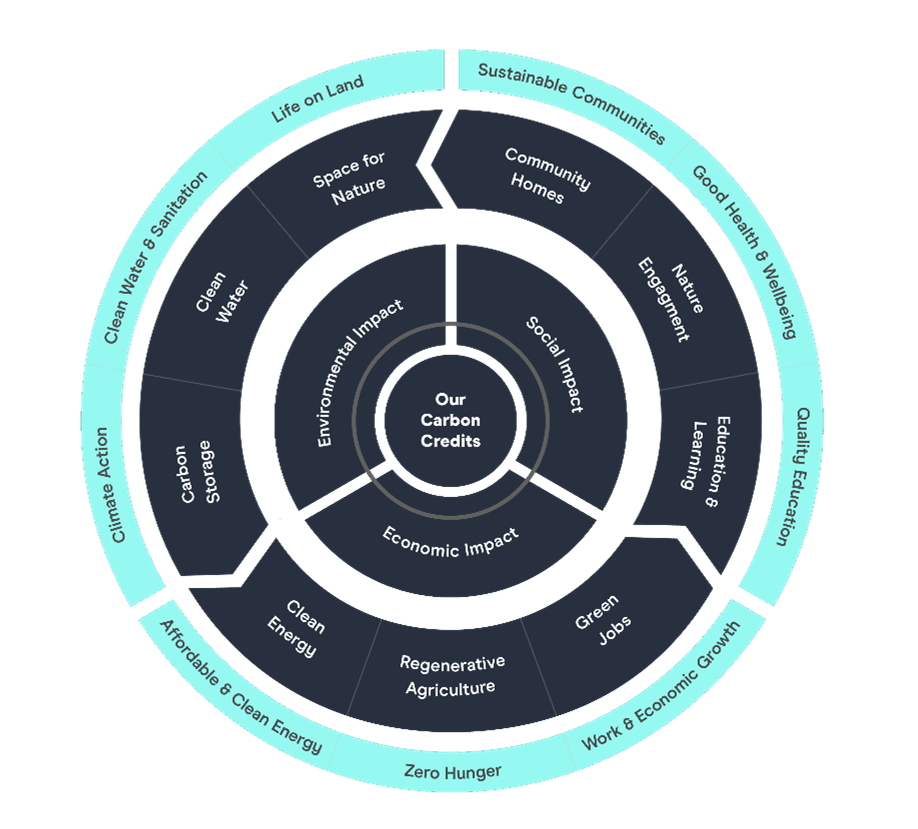| Title | Oxygen Conservation |
| Country/Location | Scotland, United Kingdom |
| Size | 23,000 acres |
| Revenue Model | Carbon credit sales via the Peatland and Woodland Carbon Codes
Other income generated from organic agriculture, property rental, renewable energy production, and ecotourism |
| Private Investment/Finance Structure | Standard commercial debt – £20.55m term loan |
| Public/Philanthropic Investment | N/A |
| Env/Social Impact | Peatlands, Forestry, Sustainable Agriculture, Biodiversity |
Summary
Oxygen Conservation is a UK-based company that invests in land to protect and restore natural capital. In 2023, Oxygen Conservation acquired two estates in Scotland; Blackburn and Hartsgarth, and Invergeldie, which cover 23,000 acres. These acquisitions were completed through the use of a £20.55m loan facility from Triodos Bank UK – which as of September 2023 is believed to be the largest conservation-focused commercial package in the UK. Income is based on the sale of carbon credits generated through the Peatland and Woodland Carbon Codes.

Oxygen Conservation is a subsidiary of Oxygen House Group, an investment group focussed on delivering positive environmental and social impact. Oxygen Conservation was set up in 2021 with a mandate from the Group to scale nature conservation across the UK. The Oxygen Conservation team has expertise in the delivery of complex, long-term conservation projects, as well as project finance. It is working to apply this expertise to the nature finance space.
Oxygen Conservation is targeting the acquisition and management of 250,000 acres of land for nature restoration by 2025 across the UK. It screens numerous sites each year to look for the best opportunities to deliver conservation at scale.
To finance these acquisitions, Oxygen Conservation uses its capital through Oxygen House Group. However, on a case-by-case basis, it also considers the use of external repayable finance, such as commercial loans.
Project inception
In 2022, Oxygen Conservation identified two estates in Scotland – Blackburn and Hartsgarth, and Invergeldie, which cover a collective 23,000 acres. Chris White, Director of Natural Capital at Oxygen Conservation, says that “the estates screened incredibly well for a range of criteria, including carbon sequestration and storage, renewable energy potential, organic food production, and delivery of conservation at scale.” Both sites are former grouse moors with low environmental baselines creating opportunities for delivering an uplift in natural capital value to benefit both the local population and wildlife.

The loan is structured as a term loan of £20.55m with a repayment period of 25 years, with an interest only period for the first five years. The loan proceeds will mainly be used for the acquisition and nature restoration works – including peatland restoration and woodland planting.
Instead of a fixed repayment schedule, Triodos offered a flexible arrangement that would trigger repayments based on the sale of carbon credits – including Pending Issuance Units (PIUs) and verified Woodland and Peatland Carbon Units. Triodos also has the option of varying the amount repaid per credit across the 25-year timeframe, on an annual basis. It expects to take around £10 per credit sold for the first tranche of credits.
Simon Crichton, Head of Relationship Management at Triodos, comments that this flexibility is important to both the loan agreement and to the project for several reasons. “Firstly, natural processes do not follow spreadsheets, so it is important to build in flexibility for that reason alone – if there was a fire or a storm that destroyed some of the estates’ habitats, we would lower the amount taken to account for remediation works at certain points and raise future amounts to cover the difference. Secondly, nature markets operate in a nascent but increasingly popular space with potential volatility. For example, what if there is a shortage of tree saplings when Oxygen wants to do most of its planting? This might mean it needs to create tree nurseries onsite that again would necessitate more funds freed up in the near term,” says Crichton.
Natural capital plans
Both estates have long-term strategic management plans that were developed by the Oxygen Conservation team. Full time estate managers are being employed to manage day to day activities.
As part of due diligence for the term loan, Triodos analysed these plans and engaged independent land advisors Strutt and Parker and John Clegg & Co to provide a further level of assurance as to the suitability of these plans for the estates and the local environment.
Across the two sites, Oxygen Conservation hopes to deliver 6,500 acres of new native woodlands and 7,000 acres of restored peatlands, storing over 1 million tonnes of carbon.
The management plans for both estates have been developed in the context of their wider areas, including the local communities. For example, Blackburn & Hartsgarth neighbours 10,500 acres of the Tarras Valley Nature Reserve. Oxygen Conservation is hoping to work with the Langholm Initiative (the community landholder) to connect its habitats to the Reserve and increase one of the most important breeding areas for the UK’s most threatened bird of prey – the hen harrier. Likewise, Invergeldie has public access routes that will be maintained and enhanced for communities and visitors. Both estates have operational farmland that will be transitioned to organic and regenerative agriculture, with the food produce sold locally.
To help deliver impact, Oxygen Conservation has developed several long term partnerships with specialist advisors. For example, it has engaged TreeStory on designing and implementing the native woodland creation and peatland restoration, Low Carbon on renewable energy generation, Galbraiths on organic, regenerative agriculture, and the Lifescape Project on biodiversity and conservation management.
Challenges
Key challenges in developing this project – including the natural capital plans and the loan agreement – were:
- Uncertainty in carbon markets, which made cash flow projections challenging
- Complex land use trade-offs, such as where tree planting would be best suited to the land, for which a significant amount of data was needed to make informed decisions
- Environmental challenges of creating and maintaining native habitats – for example deer management, disease and pests, fire risk
- Longer time horizons – requiring not only significant up-front investment, but also a flexible financing approach
- Community engagement – working with the local community to embed their views and accept their challenges to the project’s approach requires compassion and patience – often on complex and contentious issues
Measuring outcomes
Carbon credits will be delivered across both Estates, measured in tonnes of carbon dioxide equivalent sequestered or avoided, as defined and measured by the Peatland and Woodland Carbon Codes. These will be verified by independent auditors as specified in the Codes.
In addition, an external third party has been contracted by Oxygen Conservation to undertake a woodland carbon baseline at both sites, using a combination of drone surveys, satellite imagery, LIDAR, and AI to estimate the carbon stored within each individual tree. This survey will be repeated in future to allow a detailed picture to be built up of the carbon stored across the estates, over and above what is required within the Codes.
Alongside carbon, a natural capital accounting approach is being used to record a range of quantitative metrics across the sites’ natural capital assets – including ecosystems, atmosphere, soil, water, and species.
The outcomes for both sites will be measured against nine ESG KPIs aligning with nine of the UN SDGs on an annual basis to monitor progress of each project against the estates’ strategic plans, these include:
- Environmental: carbon storage, space for nature, and clean water
- Social: community homes, nature engagement, and education and learning
- Economic: clean energy, regenerative agriculture, and green jobs

The deal was completed and announced to the public in April 2023. It was believed to be the largest conservation-focused commercial debt package in the UK to date.
There was a generally positive response from the media and the public, although there was some pushback on the fact that this was a private company acquiring land, which ties into the ‘green laird’ narrative of land not being under local ownership or concerns around profit maximisation being prioritised over nature conservation. Both Oxygen Conservation and Triodos anticipated this response, and Oxygen Conservation has stated that it is open to such criticism and is keen to take feedback on how to best create benefits for the local community.
“We need leaders like Oxygen in the sector to develop the financing approach,” adds Crichton. “Just as we saw in the renewable energy sector in the 1980s, where Triodos developed approaches that, in maturity, enabled community engagement, benefit and ownership. We hope we can accelerate this learning in the natural capital field.”
Sources
- Interview with Chris White and Elly Steers, Oxygen Conservation
- Interview with Simon Crichton, Triodos Bank UK
- ‘Oxygen Conservation and Triodos Bank UK announce landmark conservation-focused debt package’, Press Release, Triodos Website, April 2023
Photos credit: Josh Craddock